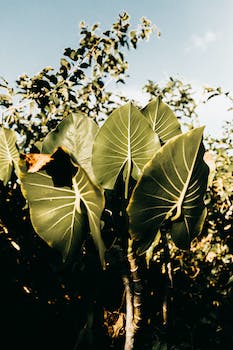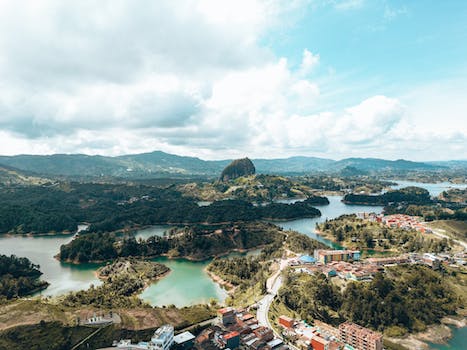

-
Table of Contents
America's Towering Giant: The Majestic Sequoia
Introduction
The Majestic Sequoia: America's Towering Giant is an introduction to the awe-inspiring Sequoia trees found in the United States. These towering giants are renowned for their immense size, longevity, and ecological significance. This article explores the unique characteristics, historical significance, and conservation efforts surrounding the majestic Sequoia trees, providing readers with a glimpse into the world of these remarkable natural wonders.
The History and Significance of the Majestic Sequoia
The majestic sequoia, also known as the giant sequoia or Sequoiadendron giganteum, is a towering giant that holds a significant place in America's natural history. These magnificent trees have captured the imagination of people for centuries, and their history and significance are deeply intertwined with the development of the United States.
The story of the majestic sequoia begins long before the arrival of European settlers. Native American tribes, such as the Miwok and the Yokuts, revered these trees and considered them sacred. They used the sequoias for various purposes, including shelter, food, and medicine. The tribes believed that the trees possessed spiritual powers and held ceremonies beneath their massive branches.
However, it was not until the mid-19th century that the majestic sequoia gained widespread attention. In 1852, a hunter named Augustus T. Dowd stumbled upon the giant trees while exploring the Sierra Nevada Mountains in California. He was astounded by their size and reported his discovery to the world. News of the colossal sequoias spread rapidly, attracting curious visitors from all over the country.
One of the most famous sequoias, known as the General Sherman Tree, was named after General William Tecumseh Sherman, a Union Army officer during the American Civil War. This tree, located in Sequoia National Park, is the largest known living single-stem tree on Earth. It stands at a staggering height of 275 feet and has a circumference of over 100 feet. The General Sherman Tree is estimated to be around 2,200 years old, making it one of the oldest living organisms on the planet.
The significance of the majestic sequoia goes beyond its impressive size and age. These trees play a crucial role in the ecosystem, providing habitat for numerous species of plants and animals. The thick bark of the sequoias acts as a natural fire-resistant shield, allowing them to survive wildfires that would destroy most other trees. Additionally, the fallen sequoia logs create a nutrient-rich environment for new growth, contributing to the cycle of life in the forest.
The conservation of the majestic sequoia has been a priority for the United States since the late 19th century. In 1890, President Benjamin Harrison signed legislation establishing Sequoia National Park, the second national park in the country. This protected area was created to preserve the groves of giant sequoias and ensure their survival for future generations.
Today, the majestic sequoia continues to inspire awe and wonder in those who encounter them. Visitors to Sequoia National Park and other protected areas can witness the grandeur of these towering giants up close. The experience of standing next to a sequoia, feeling the rough texture of its bark and gazing up at its lofty branches, is a humbling reminder of the power and beauty of nature.
In conclusion, the history and significance of the majestic sequoia are deeply rooted in America's natural heritage. From their sacred status among Native American tribes to their role in the ecosystem and their conservation efforts, these towering giants have captured the imagination of people for centuries. The majestic sequoia stands as a testament to the resilience and magnificence of nature, reminding us of the importance of preserving and protecting our natural treasures.
Exploring the Natural Habitat of the Majestic Sequoia

The majestic sequoia, also known as the giant sequoia or Sequoiadendron giganteum, is one of the most awe-inspiring trees in the world. These towering giants can reach heights of up to 300 feet and have a trunk diameter of over 30 feet. Native to the western slopes of the Sierra Nevada mountains in California, the natural habitat of the majestic sequoia is a sight to behold.
The natural habitat of the majestic sequoia is characterized by a unique combination of factors that contribute to the tree's impressive size and longevity. These factors include the region's climate, soil composition, and fire ecology.
The climate in the natural habitat of the majestic sequoia is Mediterranean, with hot, dry summers and cool, wet winters. This climate provides the perfect conditions for the tree to thrive. The hot summers allow the sequoia to photosynthesize and grow rapidly, while the cool winters provide the necessary moisture for the tree's survival.
The soil composition in the natural habitat of the majestic sequoia is also crucial to its growth. The sequoia requires deep, well-drained soil that is rich in nutrients. The soil in the Sierra Nevada mountains is derived from granite and is highly weathered, providing the perfect conditions for the tree's roots to penetrate deep into the ground and access the necessary nutrients.
Fire plays a vital role in the natural habitat of the majestic sequoia. Unlike most trees, the sequoia has adapted to survive and even thrive in the presence of fire. The thick bark of the sequoia acts as a protective shield against fire, allowing the tree to withstand even the hottest flames. In fact, fire is necessary for the sequoia's reproduction. The heat from a fire opens the cones and releases the seeds, creating a fertile environment for new sequoias to grow.
Exploring the natural habitat of the majestic sequoia is a truly awe-inspiring experience. The towering trees create a sense of wonder and amazement, as if stepping into a prehistoric world. The sheer size and grandeur of the sequoias are enough to leave anyone speechless.
One of the best places to explore the natural habitat of the majestic sequoia is Sequoia National Park. Located in the southern Sierra Nevada mountains, this national park is home to some of the largest and oldest sequoias in the world. The park offers a variety of hiking trails that allow visitors to get up close and personal with these magnificent trees.
Another popular destination for exploring the natural habitat of the majestic sequoia is Kings Canyon National Park. Adjacent to Sequoia National Park, Kings Canyon is known for its deep canyons and towering cliffs. The park is home to the General Grant Tree, one of the largest sequoias in the world. Visitors can take a leisurely stroll through the Grant Grove and marvel at the sheer size and beauty of these ancient trees.
In conclusion, the natural habitat of the majestic sequoia is a truly remarkable place. The combination of the region's climate, soil composition, and fire ecology creates the perfect conditions for these towering giants to thrive. Exploring the natural habitat of the sequoia is an experience that will leave you in awe of the beauty and grandeur of nature. Whether visiting Sequoia National Park or Kings Canyon National Park, witnessing these majestic trees in their natural habitat is an experience that should not be missed.
Conservation Efforts to Protect the Majestic Sequoia
The majestic sequoia, also known as the giant sequoia or Sequoiadendron giganteum, is one of the most iconic trees in America. These towering giants can reach heights of up to 300 feet and have a lifespan of over 3,000 years. With their massive trunks and thick, fire-resistant bark, they have become a symbol of strength and resilience. However, despite their grandeur, these magnificent trees are facing numerous threats, including logging, climate change, and disease. To ensure the survival of the majestic sequoia, conservation efforts have been put in place to protect and preserve these ancient giants.
One of the primary conservation efforts to protect the majestic sequoia is the establishment of national parks and reserves. The most famous of these is Sequoia National Park, located in California's Sierra Nevada mountains. This park was established in 1890 and encompasses over 400,000 acres of land, including the largest concentration of giant sequoias in the world. By designating these areas as protected, it ensures that the sequoias and their surrounding ecosystems are safeguarded from logging and other destructive activities.
In addition to national parks, there are also private organizations dedicated to the conservation of the majestic sequoia. The Save the Redwoods League, founded in 1918, has been instrumental in acquiring and protecting land for the preservation of these ancient trees. Through their efforts, they have helped expand existing parks and establish new reserves, ensuring that more sequoias are protected for future generations to enjoy.
Another crucial aspect of conservation efforts is the management of wildfires. While it may seem counterintuitive, fire plays a vital role in the life cycle of the majestic sequoia. The heat from fires helps to open the sequoia cones, allowing the seeds to be released and germinate. However, the frequency and intensity of wildfires have increased in recent years due to climate change, posing a significant threat to the sequoias. To mitigate this risk, controlled burns and other fire management techniques are employed to reduce fuel loads and prevent catastrophic wildfires that could destroy entire groves.
Climate change is perhaps the most significant long-term threat to the majestic sequoia. Rising temperatures and changing precipitation patterns can have a detrimental impact on these trees. Drought conditions, in particular, can weaken the sequoias and make them more susceptible to disease and insect infestations. To address this issue, scientists and conservationists are studying the effects of climate change on the sequoias and developing strategies to mitigate its impact. These include measures such as planting sequoias in cooler, higher elevation areas and implementing irrigation systems to ensure their survival during drought periods.
Lastly, efforts are being made to raise awareness about the importance of the majestic sequoia and the need for its conservation. Educational programs, guided tours, and interpretive centers within national parks help visitors understand the significance of these ancient trees and the threats they face. By fostering a sense of appreciation and understanding, it is hoped that more people will become advocates for the protection of the sequoias and support conservation efforts.
In conclusion, the majestic sequoia is a national treasure that requires dedicated conservation efforts to ensure its survival. Through the establishment of national parks, private organizations, and the management of wildfires, steps are being taken to protect these ancient giants. Additionally, addressing the challenges posed by climate change and raising awareness about the importance of the sequoias are crucial in securing their future. By working together, we can ensure that America's towering giants continue to inspire awe and wonder for generations to come.
Q&A
1. What is the Majestic Sequoia?
The Majestic Sequoia is a type of tree native to the western United States, known for its impressive size and height.
2. How tall can the Majestic Sequoia grow?
The Majestic Sequoia can grow to be over 250 feet (76 meters) tall, making it one of the tallest tree species in the world.
3. Where can the Majestic Sequoia be found?
The Majestic Sequoia is primarily found in California's Sierra Nevada mountain range, specifically in designated national parks such as Sequoia National Park and Kings Canyon National Park.
Conclusion
In conclusion, the majestic sequoia is a towering giant that holds great significance in America. Its impressive size, longevity, and ecological importance make it a symbol of strength and resilience. The sequoia's presence in national parks and forests serves as a reminder of the country's natural beauty and the need for conservation efforts to protect these magnificent trees for future generations.












